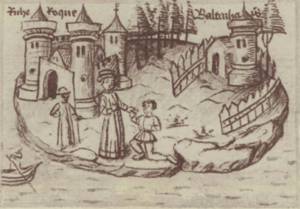Kingdom of the Canary Islands facts for kids
Quick facts for kids
Kingdom of the Canary Islands
|
|||||||||||
|---|---|---|---|---|---|---|---|---|---|---|---|
| 1404–1448 | |||||||||||
| Status | Vassal state of the Crown of Castile | ||||||||||
| Capital | Betancuria (1404–1425) Teguise (1425-) |
||||||||||
| Common languages | Old Norman, Early Modern Spanish, Guanche |
||||||||||
| Religion | Catholicism (Official), Guanche religion |
||||||||||
| Government | Monarchy | ||||||||||
| King | |||||||||||
|
• 1404–1425
|
Jean de Béthencourt | ||||||||||
|
• 1425–1448
|
Maciot de Béthencourt | ||||||||||
| Historical era | Middle Ages | ||||||||||
|
• Conquest of Lanzarote
|
1404 | ||||||||||
| 1448 | |||||||||||
|
|||||||||||
| Today part of | Spain | ||||||||||
The Kingdom of the Canary Islands was a small kingdom that existed on some of the Canary Islands. It was like a smaller state that was loyal to the Crown of Castile (a powerful kingdom in Spain). This kingdom lasted for about 44 years, from 1404 to 1448.
Contents
Early European Visitors to the Canary Islands
Long before this kingdom, other Europeans had visited the Canary Islands. One of the first known was a sailor from Genoa (a city in Italy) named Lancelotto Malocello. He landed on the island of Lanzarote in 1312. He stayed there for almost 20 years. However, the native people, called the Guanches, rebelled. Their king, Zonzamas, led the revolt and forced Malocello to leave.
Conquest of the Canary Islands
The conquest of the Canary Islands began in 1402. A French explorer named Jean de Béthencourt led this effort. He had sailed from France a year earlier with a small army. He started by taking over the island of Lanzarote. He did this in a friendly way, with help from the local people. Soon after, his forces also took control of Fuerteventura and El Hierro. The king of Lanzarote at that time was Guadarfia, who was the grandson of King Zonzamas.
When Béthencourt left the island to get more help from Castile, problems started. There was fighting between two of his Norman officers, Gadifer de la Salle and Berthin. The native people got involved in these fights. When Béthencourt returned, he managed to calm things down. The Guanche leader was baptized on February 27, 1404. This meant he officially gave up control to the Europeans.
After this, Pope Innocent VII declared Jean de Béthencourt the king of the Canary Islands. However, Béthencourt still recognized the Castilians as his rulers. The remaining islands, including La Gomera, Gran Canaria, Tenerife, and La Palma, were slowly conquered over the next century.
Changes in Leadership and Ownership
After Jean de Béthencourt died, his nephew Maciot de Béthencourt became the new ruler. Maciot was not a good leader and was seen as a tyrant. He moved the capital to a new town called Teguise.
At this time, Portugal was also trying to gain control of the islands. The Castilians worried that Maciot might sell the islands to Portugal. Their fears came true in 1448 when Maciot sold the islands. Neither the native people nor the Castilians approved of this sale. This led to a revolt that lasted until 1459. Eventually, the Portuguese were forced to leave the islands. In 1479, Portugal officially agreed that Castile was the rightful ruler of the Canary Islands. This agreement was part of the Treaty of Alcáçovas.
The military governor Alonso Fernández de Lugo finished the conquest of the islands. He conquered La Palma between 1492 and 1493. He then conquered Tenerife between 1494 and 1496. This completed the full takeover of the Canary Islands for the Crown of Castile.
See also
 In Spanish: Islas de Señorío para niños
In Spanish: Islas de Señorío para niños




